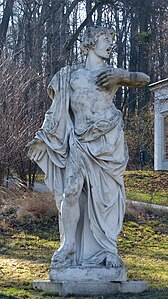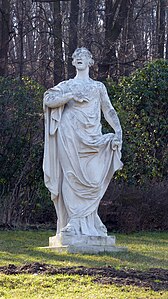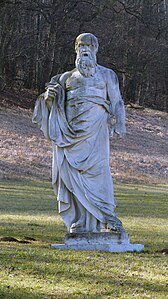Pötzleinsdorf Palace Park
The Pötzleinsdorfer Schlosspark (also: Pötzleinsdorfer Park ) is a park in the 18th district of Währing in Vienna .
location
The park extends elliptically along the northern slope of the Schafberg between Pötzleinsdorfer Straße and Geymüllergasse in the north and Ladenburghöhe and Schafberggasse in the east and south. In the west it is bounded by an unnamed path that leads from the west end of Ladenburghöhe to the west end of Pötzleinsdorfer Straße.
history


The approximately 354,000 square meter facility, designed in the style of an English landscape garden , was privately owned until 1935. The park was laid out in the eighteenth century by Philippina von Herberstein and redesigned from 1797 by Johann Heinrich Geymüller , and executed by the gardeners Konrad A. Rosenthal and Franz Illner.
In the first decades of the nineteenth century the park became a popular meeting place and summer retreat for the Viennese upper class. After the bankruptcy of the Geymüller bank in 1841, the entire property was sold and from then on had changing owners, who let the facility fall into disrepair. In 1868 the facility came into the possession of the Ladenburg-Ellisen family. When plans to subdivide the park were circulating after the First World War, it was bought by the furniture manufacturer Max Schmidt , who became its last private owner. He bequeathed it to the municipality of Vienna, which opened it to the population from 1935. The park was hit by aerial bombs during the Second World War and reopened in June 1949 in the presence of Mayor Theodor Körner .
Preserved historical elements are a pleasure house in the classical style and a bath grotto as well as a memorial stone to the poet Johann Baptist von Alxinger . The Swiss house that has not been preserved used to offer a view of the city from the hill.
On June 18, 2012, a major fire destroyed part of the farm buildings on the site.
The park is a local recreation area and popular destination. A large storage area with a children's playground and petting zoo as well as an open-air aviary was built for this purpose . There are also two small soccer fields on the area. The park is fenced and closed from dark until morning. It is one of the most important garden architectural monuments in Austria and is under monument protection ( No. 50 in the appendix to Section 1, Paragraph 12 of the DMSG and in the list of monuments )
In the eastern part of the park is the Pötzleinsdorf Castle , which today houses a Rudolf Steiner School .
"Singing Quartet"
The four figures on the pilasters of the attic of the Vienna Ring Theater, the so-called "Singing Quartet" (soprano, alto, tenor, bass) survived the fire of the Ring Theater on December 8, 1881 by over 100 years and are now in the front as figurines Parking area. They were installed in the theater by the architect Emil von Förster in 1874, and after the fire, they were acquired by Max Schmidt and moved to the park.
- "Singing Quartet"
natural reserve
The green areas in the castle park are the habitat of rare animals and plants. The species that can be found here include the stock dove , Aesculapian snake , slow worm , field cricket and the middle woodpecker . In addition to its natural meadows and forests, the park also has biotopes that are worth protecting. To promote the special species and habitats, the Vienna Environmental Protection Department MA 22 and the Municipal Garden Authority MA 42 worked out a protection and maintenance concept as part of the Nature Network , the protective measures of which are implemented.
The park also belongs to the conservation area Waehring -Wienerwald (Part A, LSG 9 Total 154 ha). There are numerous natural monuments in the park .
literature
- Eva Berger: Historic Gardens of Austria: Gardens and parks from the Renaissance to around 1930 . tape 3 Vienna . Böhlau, Vienna 2004, ISBN 978-3-205-99353-7 , Vienna, Schloßpark, Schloß Pötzleinsdorf , p. 383 ff . ( Google ).
- Géza Hajós : Romantic Gardens of the Enlightenment. Vienna 1989, p. OA.
- Géza Hajós; Matthias Cremer (Ill.): Historical gardens in Austria: forgotten total works of art. Austrian Society for Historical Gardens, Böhlau Verlag Vienna, 1993, ISBN 978-3-205-98095-7 , Pötzleinsdorfer Schlosspark , p. 290 ff ( limited preview in Google book search).
- Christian Hlavac: Pötzleinsdorfer Schlosspark . In: Christian Hlavac, Astrid Göttche and Eva Berger (eds.): Historical gardens and parks in Austria. Böhlau Verlag, Vienna 2012, ISBN 978-3-205-78795-2 , pp. 357-363.
Web links
- Pötzleinsdorfer Schloßpark , website of the Vienna City Garden Authority
Individual evidence
- ↑ wien.at | Pötzleinsdorf Castle
- ^ Vienna in retrospect - June 1949 | Programmatic speech by the mayor at the opening of the Pötzleinsdorfer Park
- ↑ Major fire in Pötzleinsdorfer Schlosspark , Der Standard, June 19, 2012
Coordinates: 48 ° 14 ′ 29 ″ N , 16 ° 18 ′ 9 ″ E








